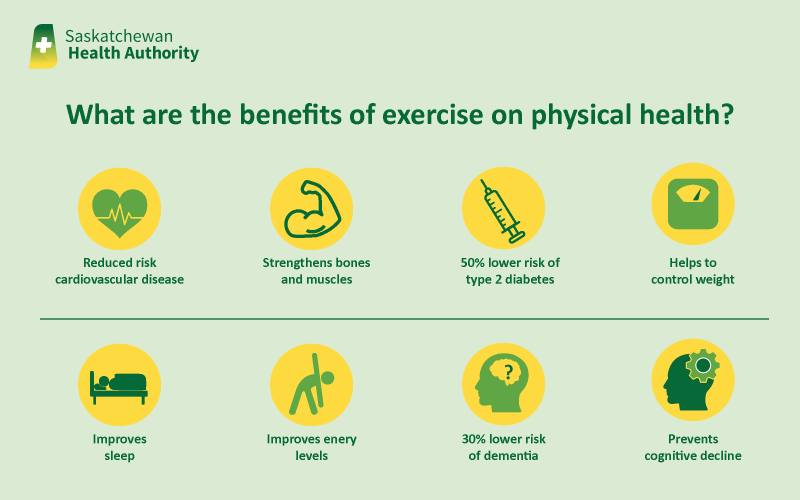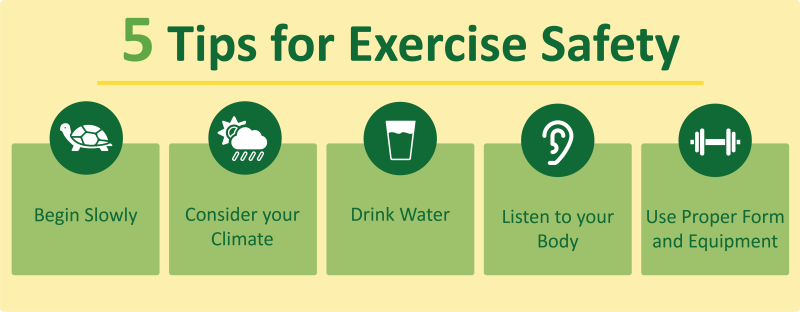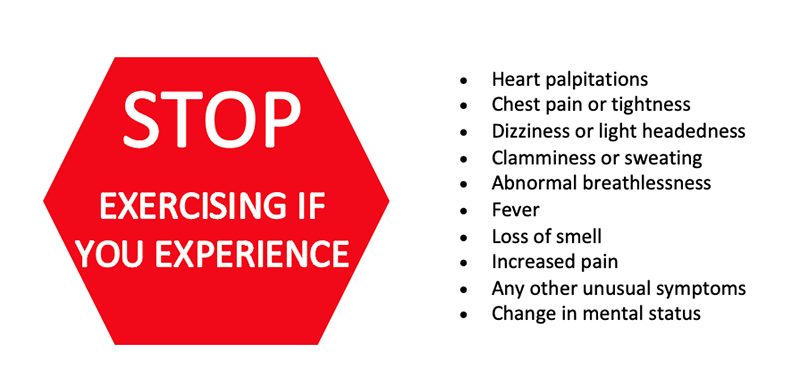Long COVID Self-Management - Exercising
What are the Benefits of Exercise?
- Better ability to be more physical.
- Improved heart and lung health.
- Improved mental health and mood.
- Increase strength and flexibility.
- Increased social involvement.
- Increased ability to do household tasks
- Increased community participation.
- Manages weight.
- Better sleep.
- Improves confidence.
- Improves balance and coordination.
- Increases energy.
- More hormones released that help reduce stress and anxiety.
- Helps calm the nervous system.
How Do I Exercise Safely?
- Do a warm-up before you exercise.
- Do a cool-down after you are done exercising.
- Wear loose, comfortable clothing and walking shoes that support your feet.
- After exercising, wait one hour before eating a meal.
- Drink lots of water.
- Avoid exercising outdoors in hot weather.
- Exercise inside when it's cold or wet outside.
What is Important to Keep in Mind When You Exercise?
- Do your exercises as planned/prescribed
- Exercising on a “bad day” may make you feel better. Exercise at a lower intensity and add in more breaks.
- Make sure you have good posture when you exercise.
- Listen to your body and do not push beyond what you can handle for that day.
- Keep the exercises simple to help feel relaxed and energized.
- Use proper breathing technique when you exercise.
Your exercise routine will be successful when combined with other strategies (e.g.: pacing, relaxation, managing your thoughts, mood and behaviour, etc.)
When Do You Exercise?
- Usually, the best time to exercise is in the morning. However, choose the time that best suits you.
- Aim to have a light breakfast (e.g.: yogurt or banana) 30 minutes before a morning work-out.
How Do I Know if I am Ready to Return to Exercise?
- No symptoms for seven days (i.e. without symptoms of fever, shortness of breath at rest, cough, chest pain, or heart palpitations)
- Activities such as bathing, getting dressed or making a simple meal should be easy to do.
- You are able to walk 500 metres on flat ground without feeling tired or out of breath. Think about how you felt before getting sick. If you were not able to walk 500 metres before getting COVID-19, you may have to adjust this guideline.
How Do I Know if I am Exercising at the Right Level?
It is best to use the BORG Rating of Perceived Exertion Scale to know if you are exercising at the right level. The British Medical Journal article Returning to physical activity after COVID-19 recommends a five-step approach to resuming exercise. This program focuses on phases 1 to 3, with a goal of a safe return to your own pre-COVID-19 level of exercise. The last two phases are meant to guide people who were involved in regular activity prior to getting COVID-19. Please talk to your medical professional if you have a goal of returning to this level of activity.
As you go through the steps, there are suggestions on how you should be feeling with the level of exercise and breathing. Remember, these are meant to help you be successful in getting back to pre-COVID-19 activity levels. You should only exercise if you feel recovered from the previous day and COVID-19 symptoms have not gotten worse.
COVID-19 has affected everyone differently, so it is important to work at a pace that is right for you. As a result, progress through the phases described below will not be the same for everyone. Be patient with yourself, stick to it, and reward yourself for all your hard work.
Precautions
You should seek medical help immediately for chest pain, shortness of breath, and dizziness that does not resolve with rest or any change in mental status.
You Should Not Exercise Alone if
- You have a hard time doing typical daily activities on your own. The program may need to be modified to fit your needs.
- You had falls prior to going into the hospital and/or you have concerns about your balance.
- You have other medical conditions that puts your health at risk if you exercise.
- You have been sent home with a prescription for oxygen. It is very important that you discuss the use of oxygen during exercise with your health care provider.





